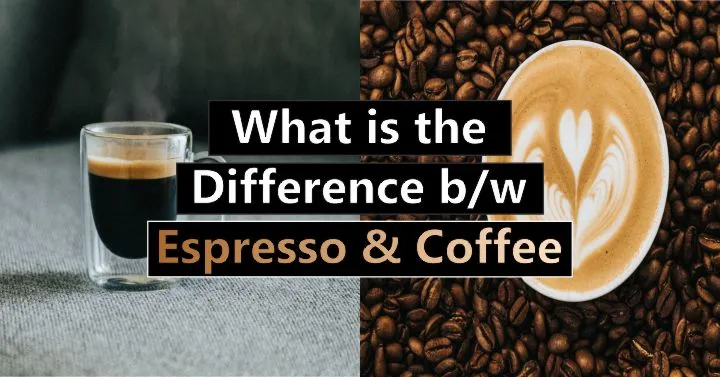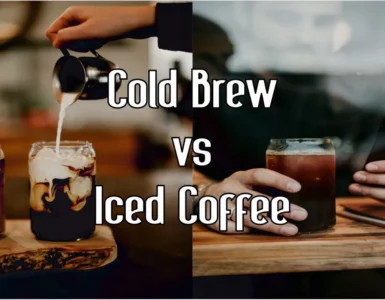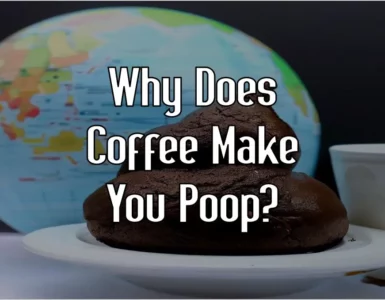How coffee and espresso are made makes them different, starting with the beans. Mostly, coffee beans that will be used to make espresso are roasted longer than beans that will be used to make drip coffee. Espresso beans are also crushed more sand-like than gravel.
The beans’ effectiveness would affect the taste, but the most significant difference between espresso and coffee is how it is made. Beans roasted for espresso can be used to make drip coffee, while beans roasted for espresso can be used to create espresso.
Some people think a small cup of robust espresso is the only real coffee, while others think it’s a waste of good beans and tastes bitter. No matter what you like, it’s always good to try something new and get out of your comfort zone.
Most people understand that coffee and espresso are not the same things, but do you know what the difference between espresso and coffee is? This article compares espresso and coffee, two of the world’s most popular coffee drinks.
What is Coffee?
Let’s begin with a few simple definitions. In your mind’s eye, you probably picture a steaming mug of dark liquid prepared in an automatic drip coffee maker or by hand in a French press or pour-over kettle.
Many Americans’ daily routines wouldn’t be complete without a cup of coffee, which is why it’s such a common household item. Depending on your preference for strength, coffee is often served in portions of 6-8 ounces and brewed with a ground-to-water ratio of 1:18.
Dark, medium, or light roast coffee beans are ground semi-coarsely to make this brew.
What Is Espresso?
This coffee production method is known as espresso, and its small size and intense flavor characterize it.
A large amount of hot water is pumped through the coffee grinds at a rapid and high rate to make espresso. Because of this, an espresso machine is needed. It took a lot of scientific know-how to get an espresso machine to work in the late 19th century.
Pour-overs, on the other hand, are a lot more straightforward way to make coffee. All you need is a cup of coffee and some water. Japanese innovation in pour-overs has led to considerable advances in beverages.
Some individuals think espresso is the purest form of coffee, while others favor pour-overs for their more mellow and easy-drinking qualities. If you’re a good barista, you can use any brewing method.
Espresso Beans vs Coffee Beans: The Brewing Method
The Coffea plant is the source of all coffee. ‘Espresso beans’ and regular coffee beans have no discernible differences. The way coffee and espresso are prepared and brewed makes them distinct from one another, not the beans themselves.
Roasting
It is impossible to make coffee with beans that are still too pale green after they are collected. They must be roasted to bring out their most outstanding qualities.
Espresso beans are roasted to a particularly dark color to resist better the high pressures at which they are brewed. Additionally, the moderate acidity of a dark roast makes it ideal for sipping with milk.
Pour-overs usually bring out the coffee’s brighter, fruitier tastes and are best suited for lighter roasts. What matters is what you prefer. Go ahead and experiment with some new beans!
Grinding
Espresso is one of the most challenging ways to make coffee because of its precision. Working under extremely high pressure and with a limited time frame requires much scientific knowledge.
Even the tiniest adjustments will have a noticeable effect on your cup if you stay within these parameters.
The bitter and over-extraction of espresso because of the small grind size results from a coarse grind. Espresso grinds should be fine, between flour and table salt in fineness.
The grind size for pour-overs tends to be coarser. For a good cup of espresso, you need a high-quality grinder.
A hand grinder like the Hario Skerton is convenient for processing some beans for a pour-over, but it struggles to produce a fine enough grind size and consistency for an espresso. A good machine grinder, like the Baratza Virtuoso, is required to achieve the optimum espresso grind.
Brewing
For this, the preceding phases have been only a prelude. There are numerous methods for making filter coffee that all use the same basic premise. However, an espresso machine is required to make this type of coffee.
Roughly 9 bars of pressure are used in an espresso machine to force hot water through coffee grounds in about 20-30 seconds. Every aspect of the cup’s design is critical to its final performance.
Automatic, semi-automatic, and manual espresso machines are all valid options. Baristas no longer need to know all the intricacies of their espresso machine to make the perfect cup.
Every Big Difference between Espresso and Coffee
Serving Capacity
A typical serving size for coffee is 8 ounces, while espresso comes in 1-ounce portions. Espresso is frequently mixed with coffee and served in shot form. For drinks like lattes, cappuccinos, and Americanos, espresso is the basis. Espresso can, of course, be enjoyed on its own, without adding coffee or milk.
Five different sizes of drip coffee and two different amounts of espresso are available at Starbucks. In addition to the 8-ounce Small, 12-ounce Large, 20-ounce Venti, 16-ounce Grande, and 30-ounce Trenta, drip coffee is also offered in other sizes (31 oz.).
Espresso is available in two serving sizes: Solo (1 ounce) and Doppio (2 ounces) (2 oz.). European espresso cups are divided into four typical sizes: ristretto, single shot, lungo, and double shot (2 oz.).
Flavor
It’s important to know that espresso and coffee have distinct flavors. Espresso has a more distinct flavor than a cup of drip-brewed coffee. A significant reason is that no flavor-rich oils are lost during manufacturing because no filters are used. In contrast, the flavor of drip coffee is milder.
Espresso is typically a combination of several different beans to counterbalance the bitterness of the coffee. Phytic and tannic acids can mask desired flavors in drip coffee because the paper filter eliminates many coffee beans’ natural oils.
When espresso is over-extracted or over-roasted, it will taste not very pleasant, but a correctly made espresso will not. A distinct nutty, fruity, sweet, and salty flavor profile should exist.
Pressure
The espresso machine’s lever acts as a switch, allowing for the creation of pure coffee magic. In addition to speeding up brewing, high pressure helps produce the crema and disseminate the rich coffee oils into the finished espresso shot, making it more flavorful.
To brew a cup of filtered coffee, you must rely on gravity. The pressure exerted on water and coffee by the Moka pot or the French press is insignificant when measured in atmospheric bars.
The default setting on most espresso machines is nine bars, or around 130 pounds per square inch (PSI).
Body
Coffee’s physical features, such as how it feels in the mouth, give it its body. Depending on how it is made, it might be oily or watery, or gritty; thin, medium, or thick.
The body of a coffee is influenced by its weight and consistency. A filter makes drip coffee lighter, whereas an espresso machine retains the oils that give it its fullness.
Aroma
Since coffee has such a powerful aroma, it’s a good indicator of how the cup will taste. It’s possible to detect smoky, herbaceous, nutty, fruity, and other diverse flavors. If your espresso or drip coffee smells burnt, it’s probably because it was made wrongly.
Bitterness
Espresso preparations, in particular, benefit from the bitterness detected in the mouth’s back. Arabica beans have a sweeter flavor, and Robusta beans have a more bitter aftertaste. At the tip of the tongue, the sweetness of coffee is usually modest and smooth.
Acidity and pH Level
A sour, unpleasant bitterness is not the same as a sour, unpleasant acidity. It’s a taste-based ‘measurement’ High acidity is “bright,” low acidity is “smooth,” and too low is “flat.” Adding sugar to coffee boosts its sweetness by sweetening its acidity.
Coffee generally has a pH of 5, making it significantly less acidic than tomato juice but somewhat more acidic than milk. This places it in the middle of the range.
It is possible that the phytic and tannic acids found naturally in coffee beans are to blame for the acidity experienced in the mouth and stomach.
Brewing process and the type of coffee bean used to make the grounds affect the acidity of a beverage. Both flavor and pH levels are less acidic with darker roasts. The pH level of a cold-brewed beverage is also lower.
The extraction time also affects the number of acids inside the beverage. As a result, these acids are less likely to be present in the final cup of espresso. This acidity has leached into espresso when the crema’s dark brown color changes to straw.
Also Read: 11 Best Low Acid Coffee Brands – Review
Health
Coffee’s health benefits and risks are still up in the air. Magnesium, calcium, and potassium are in drip and espresso coffee. However, while an 8-ounce serving of coffee has the same amount of magnesium as one ounce of espresso, a regular drip coffee serving has more calcium and potassium.
Some of the oils in coffee are considered suitable for the heart, while caffeine has been related to reduced cortisol response, increased metabolic response, and lowered risk of dementia.
Also Read: The 14 Surprising Health Benefits of Coffee
Who Has More Caffeine: Espresso or Coffee?
Let’s take a moment to dispel one of the most common misunderstandings about espresso and coffee: the amount of caffeine in each.
You’re probably mistaken if you believe that espresso provides more caffeine than a cup of coffee. The proper answer to the question is yes and no, as you would have guessed from the previous phrase.
On the other hand, espresso has a substantially higher concentration of caffeine if you drink the same amount as coffee. That’s hardly a surprise, especially since everyone knows that an espresso shot is significantly more concentrated than a regular cup of coffee in terms of flavor and ingredients.
However, if you look at the average serving size, you’ll see that an 8-ounce cup of coffee contains far more caffeine than a one- to the two-ounce shot of espresso.
For example, the particular values here can vary quite a bit based on the beans used, the brewing process, the temperature of the water and extraction time, and so on.
Caffeine levels in a regular cup of coffee range from 80 to 100 milligrams. As much as 700mg of caffeine can be found in some products.
On the other hand, a cup of brewed coffee typically has around 80mg of caffeine, while a standard shot of espresso contains roughly 60mg of the stimulant.
Both espresso and brewed coffee are “more” caffeine-rich than the other, depending on how you measure it, although this is a subjective comparison.
Ground Coffee vs Ground Espresso
The size of the coffee grounds comes in second in importance only to pressure. Fresh, medium-ground beans are usually the best when using a drip filter or percolator.
Making coffee in a French press calls for coarse ground coffee, which releases flavor without wasting or dissolving the particles. Too fine a grind results in harsh coffee, so go easy on it when grinding.
However, espresso is an exception. How well the espresso is extracted is determined mainly by how well the coffee cake, or “coffee bed,” functions. More beans are exposed to water because of the more delicate ground.
This indicates that the brewing process will be more efficient because of the shorter infusion time.
It’s also possible to clog the brew or slow it down with too fine a grind. Because of the pressure and insoluble sugar-based carbohydrates formed during the roast, the coffee bed swells when exposed to water.
Espresso requires a delicate balancing act between fine and medium-sized grinds.
Serving Size
Espresso has a smaller serving size than coffee, but coffee has a larger serving size. An 8-ounce cup of coffee is the average amount, although an espresso shot is only one ounce in size.
In this case, less is more because espresso is more robust and thicker than plain brewed coffee.
Also Read: 13 Best Espresso Cups
Anatomy of an Espresso Shot
Anyone who has spent time at a coffee shop knows what a shot of espresso looks like. This black brew is traditionally served in an unimpressive China cup that can hold just 50 milliliters of the beverage at a time (about 1.6 ounces).
Crema, or the “Holy Grail” of coffee foam, is a thick, brown layer that forms on top of freshly brewed coffee.
The Crema
The presence of this great foam is a sure sign of an espresso that has been properly extracted. Many things could happen when pressured water is injected into the coffee cake:
- The hot water allows the more delicate coffee oils to mix.
- Excess carbon dioxide from the roasting process is released due to the bean’s pressure exposure.
- Bicarbonate ions in the water experience a chemical reaction from being suddenly exposed to the coffee cake’s changing pH.
- The carbon dioxide can bubble up in the espresso because of the abrupt change from a high-pressure (the machine) to a low-pressure (the cup).
These forces combine to generate the espresso shot’s top layer. The crema should last about 40 minutes if your shot lasts that long. Espresso, after all, means “expressed” in Italian. Therefore, this espresso was brewed just for your use right after brewing.
The Espresso
Espresso that is brewed correctly will have a distinct flavor, silky mouthfeel, and aromatic fragrance. The shorter water exposure time removes less acid than other brewing processes while maintaining 60 to 70 percent of the caffeine in the final cup.
So, even though an espresso machine only takes 30 seconds to brew, the caffeine content is substantial. It also maintains more volatile and fragrant coffee oils that aren’t seen in your typical cup.
Conclusion
It’s all in the execution. Espresso is a type of Italian-style coffee made at high pressure and speed. You’ll need a grinder with consistent fineness and a specialized espresso machine to produce an excellent espresso.
Others, like drip coffee, are made by allowing water to filter through coffee beans slowly. It’s impossible to go wrong with any coffee drink if you love it as much as we do.
Espresso is equally gratifying as a hot cup of drip coffee in terms of flavor. A French press machine is an excellent option if you’re trying to experiment with a new type of coffee but don’t want to spend much money.
Try something different and make a full-flavored espresso drink after perfecting the espresso-making process. Cappuccinos, lattes, the red-eye, or an attempt at making South Indian filter coffee with espresso grinds are some of the more popular options.
So, it’s not a contest between espresso and coffee! Some coffee connoisseurs believe espresso is the purest form of coffee, while others prefer the more mellow and vivacious pour-overs. Ultimately, it comes down to the barista’s skill and the beans’ quality.


















Add comment